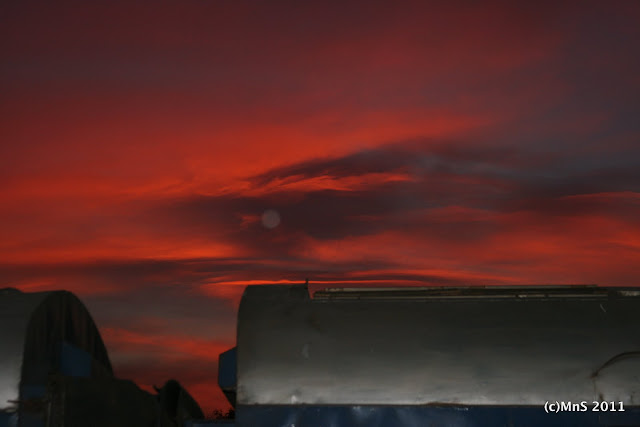In matters of faith I have fought intimate personal battles; Battles of raging tongues and explosive ideas.
But these have been different. Battles require that you choose a side, you win or loose. But what if you stand at the borderline, a confluence of thought and are torn between exploring either side....
A year or two ago we were told that marriages , special occasions and other markers of happy times should always be followed by a visit to honor local deities.
I am not a big fan of pilgrimages. I don't just find them boring, I find them annoying. To be bundled up in a car or bus only to arrive completely exhausted in a place, with only one thing in mind which is a temple some of which are heaving with people, and then go through the motions of praying is something I detest. I learn nothing, see nothing. Agnostic as I am, I am drawn to temples for other reasons.I often experience some sort of out of body experience. Not in the literal sense. But I feel like I am a story teller in my own life . I see myself watching things go by, taking everything in, spinning yarns real and otherwise in my head.
.....And so we agreed to the request.
Hinduism ancient as it is, is from a time we did not know exists. It is this ancient vastness reaching into the depths of time that completely fascinates me. So we find ourselves one Feb evening , waiting to board the train to the ancient city of Tirunelveli. We discuss history, family roots, legends and ghosts!
We finally retire for the night only to be woken up by attacking bed bugs. Sleep stays elusive.
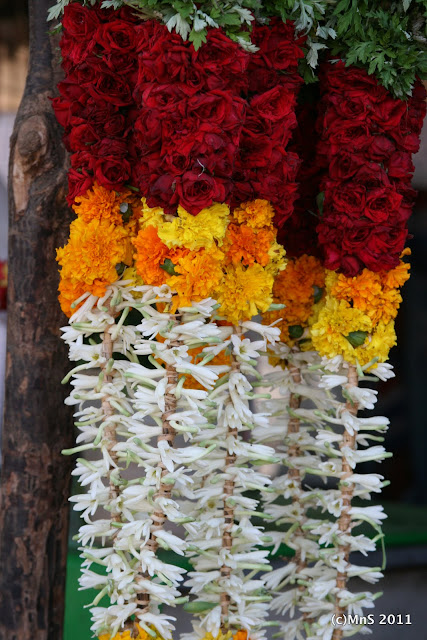
We have one whole day in the heart of the South. Showered and dressed, I get my coffee, strong and hot like the sun outside. In those days, each family had a deity they worshiped -
'Kula Deivam' they called it. What's interesting is that the deity is not part of the regular pantheon of hindu Gods and Goddesses. Rather its an idea , an image of what our ancestors from long ago had worshiped, passed on from one generation to the next along the
kulam or family
Soon we are flying past green paddy fields. Women mostly are hard at work, tiling the soil to sustenance. The roads are narrow, the traffic high. Our first stop is at the temple of
Sastha in my ancestral village of
Tharuvai.
The street looks desolate, depeopled because of the blazing sun. At a distance woman carry brightly coloured pots of water from the village tap. The houses stare back at us like old people. Most of them wear fresh coats of paint.
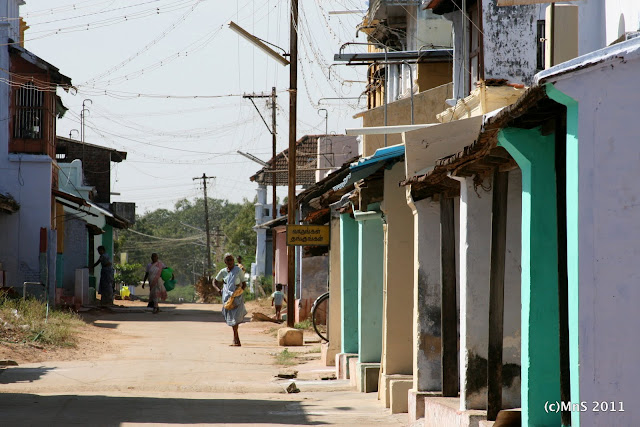
The temple is beautiful, aging gracefully and still standing tall. The ancient courtyard is full of interesting things. One corner stands the idol to Naga the snake god, decorated with bright yellows and reds of turmeric and vermilion
kumkum, The stark black of the idol in beautiful contrast to the colours it wears.

The
gopuram is white against the white sky, simplistic when compared to those with grander designs.
The symmetry of a gopuram always amazes me- Its perfect geometical shapes , the beautiful carvings, The intricacy of the craftmanship.

The priest does the aarti, honouring the gods with camphor and incense. The bright yellow flame lights up the otherwise dark sanctum sanctorum. The brass relics are exquisite

Hanging from the celiling is a lamp also made of brass, grease stained and heavy. But it has an aura of the ancient and seems proud as the bearer of light.
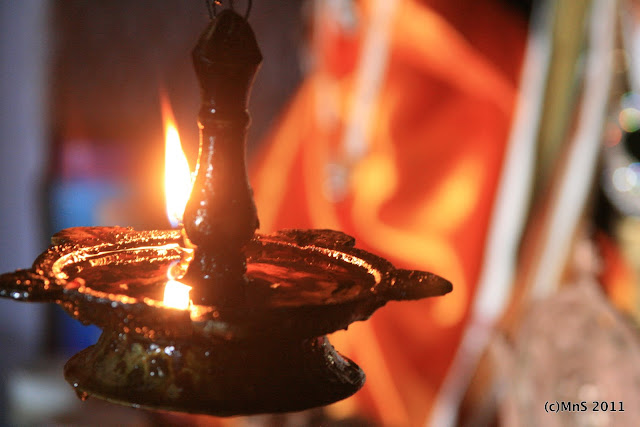
We stay a while and talk to everyone. The priest tells us about how hard it is to educate his children, the financial burdens of life in a small place. I am too distracted by the scenary outside.
As we walk, we spy a dilapidated house of two. A bullock cart stands idle, looks lost without its master and servant both of whom seem to have disappeared somewhere into the field.

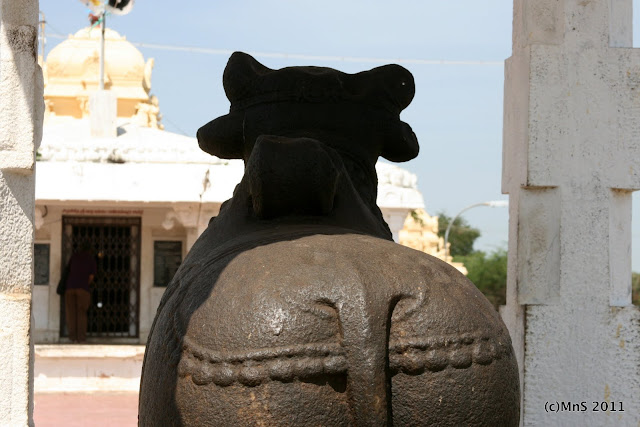
The place is strewn with temples. We find one a stones throw away from the one we have just been to. I stand behind
Nandi the bull to see what he is seeing. Again everything about how things have been placed in respect to everything else fascinates me. As the gatekeeper of Lord Shiva and Parvati he stands guard , facing the main shrine. He sees all who enter..

Green fields race away to meet the horizon. The grass flaps wildly in the summer breeze. The sun turns up the heat. We hurry along. The red and white walls of a temple call out to us from a distance.
This gopuram is colourful. I have never seen a prettier sight than this.
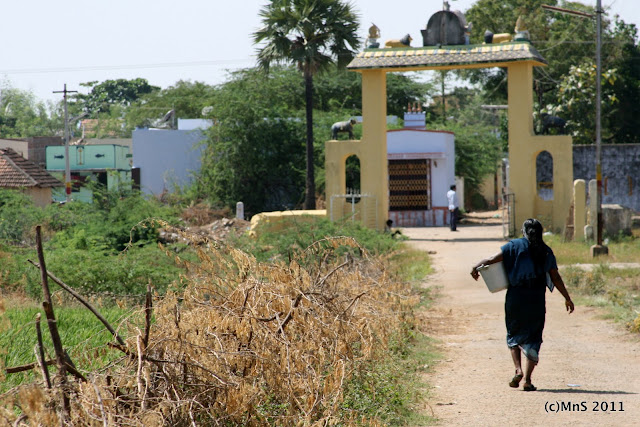
A curious woman walks past, a water pot balanced on her hip like a troublesome child. She eyes my camera. I smile a little. She ignore me.
Life is hard for these trivial niceties. I don't take offence.

Just outside the temple a river runs, hugging the sides of the bank. The beautiful banyan spreads its arm outward, a natural canopy of green over the dark waters of the green river. Women bathe silhouted in the shade of the strong banyan and its roots reach downwards as if to touch the water with its tips.

Inside the temple, we find no one . The courtyard is strewn with dolls of different shapes and sizes.They are offerings to the gods I learn.
The sun climbs higher. We tire easily and decide that it is time to head back to the confines of our car. We say goodbye and leave
Tharuvai behind in pursuit of
Thenkasi.
Tall strong men walk dusty roads, dwarfed by even taller coconut trees. Their frond like leaves shine in the bright afternoon, their barks tall and slender against the dusky earth.

The family diety of my husband's ancestors is the boy god
Murugar. As I gaze upwards at the beautiful gopuram I remember Sharanya Manivannan's very beautiful piece on the
Kavasam a few years ago and it is her I quote..
"Is there a holy text as hardcore as the Kavasam? Maybe some old Hebrew
stuff – but then, the god of the Old Testament is generally seen as
curmudgeonly and cantankerous. Unlike the adorable little Muruga,
sweet-smiling with bells around his ankles and flowers behind his ears…
who will eviscerate your enemies"

This temple is bigger than the previous one. It is beautiful. Ancient relics are placed here and there and nobody seems to know what they really are. That seems to add to the mystery of it all.
Outside the temple
'Kulam' or pond is full of grey water. People bathe , an act of purification perhaps.

This temple has a special ceremony attached to it, one we are about to witness.Legend has it that the Lord Murugar in search of sweet things , had some
Payasam( A sweet South Indian dessert) which was on the steps leading to the
Kulam. Ever since it has been ritual for people to do as he did. The recipe is ages old and has been preserved and passed along.

As I watch people eat the sugary sweet liquid off the steps leading to the waters , I do not know what to think of the whole episode. They gently wash what is left into the waters of the pond. My husband decides that he wants a piece of the action and has some himself. I take a step backwards indicating that am not as adventerous. Finally when the ritual is done we head indoors. We have some of
payasam, in plastic cups this time. It is delicious.

The gods visited , it is time for lunch, a simple wholesome affair served on Banana leaves. The banana plant is one of those of which every part is put to use. The flower, fruit and stem is eaten and the leaves are used as plates.
There is no power; for eight hours today we are told. In Chennai where we come from, load shedding is confined to two hours, and has the city constantly in complains over how difficult it is. Over here people face the absence of power stoically, a reality of life.

Outside the street is beautiful. I wonder how long it has been this way. The architecture definitely is from a long time ago. The houses here are long rather than broad and stretch from one street to the other a little apart. Most have dishevelled gardens and tiny wells , now parched in the dry heat.

Outside I spy a fruit vendor selling exotic fruit. What sort I don't know. I am told a Tamil name but I cant seem to get an English variant. Maybe none exists. Why should it. Word makes the world and the world the word itself...

We drive down to Kutralam, the waterfall reduced to a trickle makes me sad. I decide not to put up any pictures. When we head back we are surrounded by local astrologers, asking to read our palms. One is more honest and tells my Dad she needs money to buy some food. He has his palm read
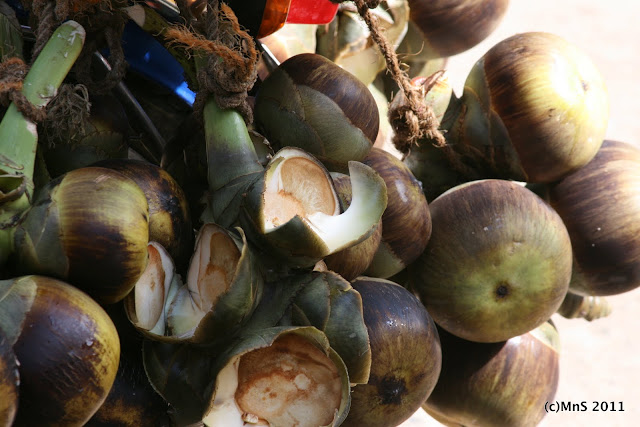
We then buy some local fruit, from some kind of palm. I have had this before but not quite in the same way. The fruit is scooped out and sugary cool liquid , sap from the same tree poured over it. We drink it all up from the criss cross leaves of the palm which has been adroitly weaved into a container.
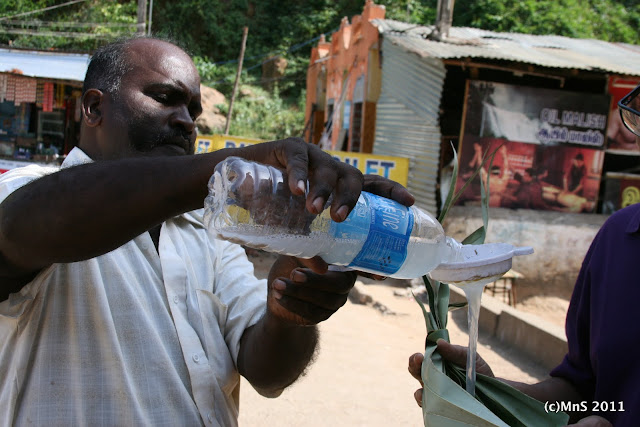
We catch the train tonight. So we hurry back and stand waiting for it to arrive in the station. The sky turns red and purple as the sun leaves this part of the world on its journey to the next.
The moon is out beaming down through the rosy streaks of blue red sky.
We say goodbye to
Tirunelveli.
